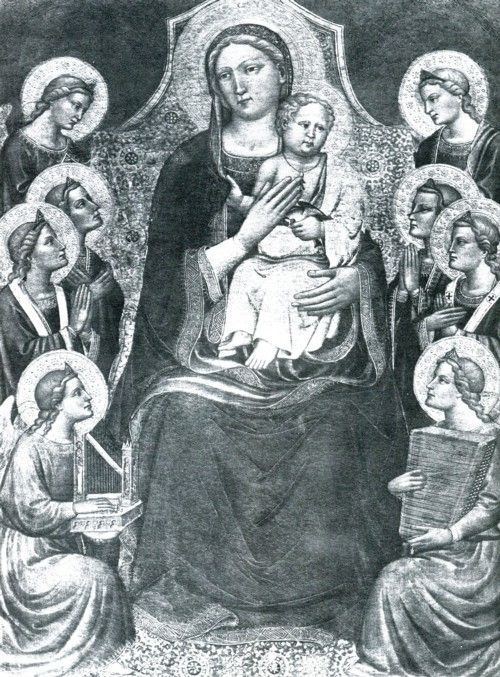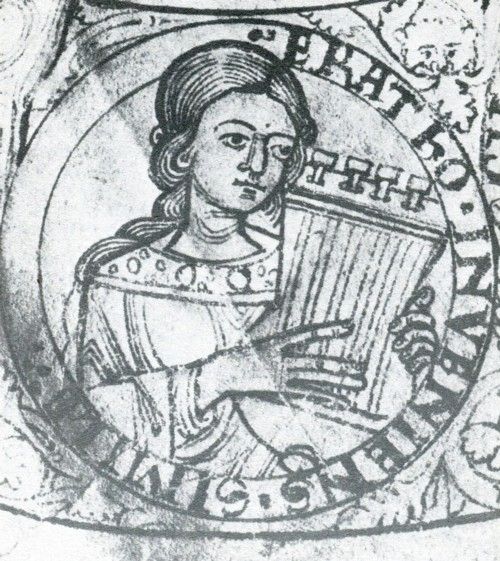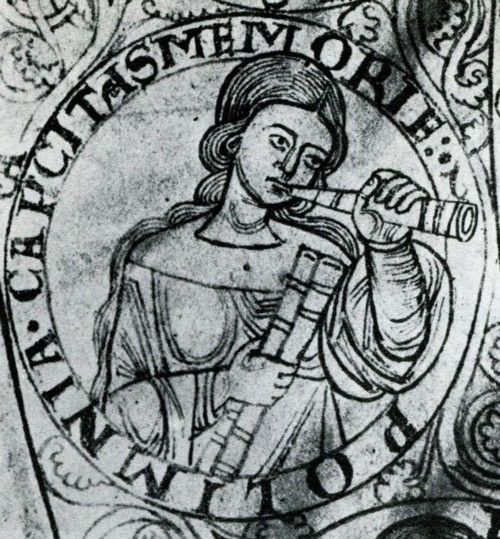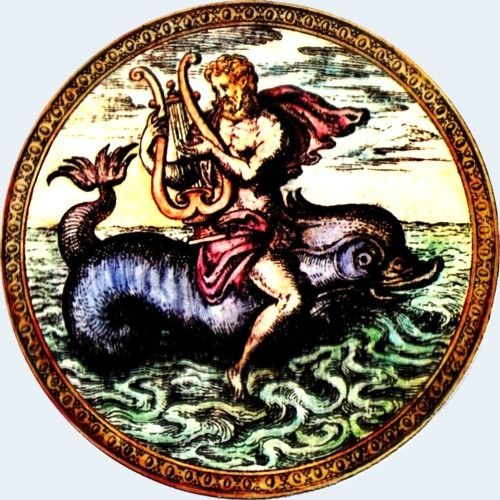Gautier de COINCY. Les Miracles de Notre-Dame
English liner notes
 LES MIRACLES DE LA VIERGE
LES MIRACLES DE LA VIERGE
(Gautier de Coincy)
The 13th century
marks a crucial stage in the spiritual evolution of Western
Christianity, and if spectacular architectural achievements could be
witnessed in the cities, the same influence could only be detected to a
very small degree in musical creations of any great importance.
There
is however no comparison to be made between the impressive though
nevertheless fragile thrust of architecture towards the heavens, and
music that was pious but devoid of any visionary greatness.
To
sum up the parallel proportions between religious thought and
architecture, we only see those strict and well thought-out
scaffoldings, which the mind carries along in the conquest of God,
existing in architecture: they consolidate the grace and transparency of
the interior space — that haven of the soul in effusion — supported by
the logical forest of buttresses, only visible to those on the outside
of the building (that is to say, to those who are not in dialogue with
divinity); these scaffoldings do not seem to have interested the
musicians of this period.
In the Northern provinces, the art of
the Trouvères developed out of the music and poetry of the Troubadours;
they inherited the delicate themes of daily life that are to be found in
the sculptures around cathedral entrances. The same kind of smile,
slightly sneering, passed from the cathedral of Reims into the couplets
of Robin et Marion. Psychology revealed itself and dragged the
stones from their sleep, from their state of inert symbolism ; it
allowed itself to be caught in the trap of musical description.
Thus
we will have to wait for the coming of Machaut and Dufay before finding
the musical equivalent of the complicated, solid outlines of the Gothic
buildings.
If in fact we make a survey of the music composed
during this period, it is curious to find that the official faith, after
the bloody suppression of the heresy of the Cathares, only inspired a
small amount of music, a production which seems to have sacrificed any
speculative developments to the urgent need of an immediate consumption,
the ideological intentions of which are not hidden: an art which was
accessible to as many people as possible, and thus it was based on forms
which were already known to a wider proportion of society, and were
suitable for carrying a unifying message. The message was the rooting of
the faith of the people in the true church, individual morality
confronted by the agonies of this world in general, and by the upheavals
of the Christian world in particular. The mind had gone on a crusade
against all unbelievers, including the personal revolt of each and every
man of those times.
In this light, it appears less mysterious to reveal that between the last organum fleuri and the far-off Messe de Tournai, the only religious works to have been written were the chansons à la Vierge and the Laude franciscaine.
Gautier de Coincy, that champion in praising the Virgin Mary, that
energetic diffuser of propaganda on the subject of the Miracles of
Notre-Dame, was only versed in the art of composition to a mediocre
extent, even if he played a musical instrument. He possessed just what
was necessary in order to choose sounds and melodies to which he could
suitably adapt and sing a text, since in his opinion, the text was of
paramount importance.
***
Who was this Gautier de Coincy
whose pious enterprise has saved him from oblivion, and to whom a whole
disc has been devoted for the first time? A lively restitution of
thirteen Chansons à la Vierge out of the nineteen titles which have been conserved is offered here.
We have taken the doubtful and parsimonious details of his life from Jacques Chailley's edition.
Born
in 1177 or 1178 in Coincy-l'Abbaye, situated near Château-Thierry,
Gautier entered the monastery of Saint-Médard, in Soissons, at an early
age under the abbé Bertrand. At 36 he was prior of Vic-sur-Aisne. Then
he returned to Saint-Médard with the title of “grand prieur claustral”
on June 19 th 1233, and it was here that he probably died on September
25th 1236. The biography is slender but the essential details are
provided, the rest being abandoned to the quibblings of specialists
since, unlike the Troubadours, we do not possess those highly precious vidas.
Slight clues in these texts allow us to think that Gautier could have
studied at the University of Paris. But what is more important here than
the silhouette of a man who escapes us and whose life must not have
suffered any great upheavals, is the contents of his work, a work which
was confined to a small geographical area: this native of the Soissons
area, a land fertile in Trouvères who spoke the langue d'oil like
the neighbouring territories of Champagne and Picardy. Conon de
Béthune, Gace Brulé, Colin Muset and many others were his
contemporaries. However he remained apart from them since the subject
matter of his inspiration was no longer to be found in the amorous
lyrical poetry of his colleagues. Obsessed, he devoted himself to an
enormous degree — some 30,000 lines — to facts, maxims and miracles
concerning the person elect among women, being at the same time virgin
and mother, and whose function as co-redemptress in the business of
soul-buying was beginning to establish itself in peoples' minds. It was a
powerful weapon against the Troubadours, singers of a heresy whose
spiritualist intentions rejected the theory of Incarnation: if Christ
only took on the appearance of man, only the Holy Spirit could
have created him. We can see that against such deviations, it was
imperative to maintain and to fortify the soul of the average man by
means of the most sensitive image, the orthodoxy of a religion that was
closely bound to its own civilization and in which the slightest breach
would have been a fatal risk of disturbance for the whole established
order. At a time when “each mass is a combat lead by the priest” (Heer),
the work of Gautier became a lesson and turned from symbolism to
allegory : the Virgin was the very emblem of catholicism.
The
poets of the South made woman a nostalgic ideal, inaccessible, far above
man who was deliberately suppressed in a state of chivalrous servitude.
Rehabilitated, but in another sense excluded.
The adoration of
the Virgin is another aspect of the rehabilitation of womankind,
unanimously condemned by the old writing, the Fathers of the Church,
just like the pagan writers, and which the Occitan civilization had
formulated.
 Gautier de Coincy took an active part in this change
of attitude, changing it round in order to serve the faith against the
sentiment. Under the protection of allegory, he finally proposed a
reassembly of he scattered, straying conscience: from Eros to Agape, the
chaste ritual of the adoration of woman was concentrated on a single
image whose intercession and permanent gift dispensed remission,
reparation, consolation and accession to a world of redemption. Woman
was in fact and simply seduction: in the all too human beauty, Satan was lying in wait.
Gautier de Coincy took an active part in this change
of attitude, changing it round in order to serve the faith against the
sentiment. Under the protection of allegory, he finally proposed a
reassembly of he scattered, straying conscience: from Eros to Agape, the
chaste ritual of the adoration of woman was concentrated on a single
image whose intercession and permanent gift dispensed remission,
reparation, consolation and accession to a world of redemption. Woman
was in fact and simply seduction: in the all too human beauty, Satan was lying in wait.
Immediately, Gautier establishes his opinion by discrediting this theory:
Love, (you) who know how to charm,
You make several (people) sing such a song
But now the souls sing something else. (1)
and he follows on with a new allegiance:
I do not wish to sing such a song,
But however sing a new song
Which the angels sing.
(“Amours qui bien...”, no 1.)
It
is strange to witness an evolution of the mind, which, in the course of
a few years, short as far as history is concerned, created not only a
new idea of the social status of woman, but here and there the
possession of a power to purify. In both cases, i.e.. the “body” and the
“mind”, the soul darted forth towards the luminous union and a land
beyond, possible because it was promised. For Gautier however, this
duality remained in its entirety and supposed a radical choice:
(Whereas) Eve by her sin
Will lead us au to an death.
Mary will deliver us
By her we are all redeemed.
(“Talenz m'est pris...”, no 4.)
In this instance, «forfait» (sin) has a meaning which warns against a more up-to-date disobedience...
It
is not without utility either to see that at the other end of the
horizon, or on the lower part of the tympanum of church entrances, this
same woman, now bestowed with a harmful power which the deteriorated
substance of mediaeval life helped to spread ; the figure of the
sorceress, less menacing than tradition had created her, sketching her
image in the shadows of pain and oppression. Darkness, the exact
opposite of virginal whiteness, the negation of all redemption, was
dispensing her derisive balm in the charred thatching; she is the proof
that the life of the people in those times was a game of trickery.
But
this would lead us far away from the sublime grazing fields where
Gautier invites the simple man of the 13th century to feed on grace and
to shed his fears and anxiety.
For scarcely a century now (middle
of the 12th century), the cult of the Virgin, partly due to the
influence of Saint Bernard, progressed to an astonishing degree. The
poetry of Gautier de Coincy, and his great work, these Miracles de Notre-Dame, represent the first stone of a literary monument which was to be embellished by many masterpieces up until the Marienleben of Rilke and Hindemith, describing the tender image of a woman who watches and intercedes.
 Gautier's “Miracles” appear as stories in verse often inspired by Latin models,
interspersed with lyrical poems, songs of devotion and of prayer. The
form is narrative and not dramatic; this came later. In fact the Miracles
that were “staged” (and, unlike the religious drama, separated from the
religious service) were only to emerge later on, taking up once more
and dramatizing Gautier's texts. They found a posterity in Rutebeuf and
above all directly influenced the famous Cantigas de Santa Maria
by Alfonso X, El Sabio, king of Castille, poet, scientist and musician.
Just as with the latter, the musical contribution of Gautier de Coincy
often limits itself to the contrafacta of already existing timbres, adding a few lines of descant called-for by his sensibility rather than his technical ability.
Gautier's “Miracles” appear as stories in verse often inspired by Latin models,
interspersed with lyrical poems, songs of devotion and of prayer. The
form is narrative and not dramatic; this came later. In fact the Miracles
that were “staged” (and, unlike the religious drama, separated from the
religious service) were only to emerge later on, taking up once more
and dramatizing Gautier's texts. They found a posterity in Rutebeuf and
above all directly influenced the famous Cantigas de Santa Maria
by Alfonso X, El Sabio, king of Castille, poet, scientist and musician.
Just as with the latter, the musical contribution of Gautier de Coincy
often limits itself to the contrafacta of already existing timbres, adding a few lines of descant called-for by his sensibility rather than his technical ability.
The
musical contribution of the poet, in agreement, operates successfully,
with the play of the rhythms, a mnemonic arsenal held in high esteem,
the calambours even, the groups of consonances, the rhythm of the
syllables which cleverly weave variations on a repetitive theme which is
somewhat spoilt by the faded imagery in the manner of the school of
Saint-Sulpice.
***
The refinements of religious thought,
the incomparable achievements in architecture, religious and
architectonic, which were reserved for an intellectual elite, hid from a
distance the true state of a world in which the miracle seemed to be
the last weapon in face of the cruelties of a determined and divided
world.
Franz Hellens wrote: “Only children and the desperate
believe in the miracle.” In this popular childlike belief, where both
archaic and Christian elements co-existed, in this social, arbitrarily
fashioned order eaten away by moral and material insecurity, the notion
of the miracle integrated itself quite naturally into daily life,
conceived as it has too often been said according to divine patterns.
It would no doubt be wrong to see only literary artifice in the choice of Gautier de Coincy. The Miracles de Notre-Dame
are the metaphors, the undeniable alchemy of the artist, beginning with
the concrete need for a redeeming mediation, the ever deceptive
expectancy of a Celestial Jerusalem, with the radiating virgin
concentrating beneficial power in the same way as a mirror concentrates
solar energy.
Unlike the too-frequent idea of this age of Faith,
the nostalgic glitter of a lost state of balance, the believer in the
Middle Ages was left with little hope of reaching the opposite bank
without risk of damnation. If we are to believe the Franciscan Berthold
of Regensurg, the chances of salvation in the 13th century were 1 to
100,000. How then in a society which was on guard against the lack of
reality of things, against the lies of the visible world where a taste
for the marvel held authority, was it possible not to make a bid for the
worker of miracles who brought at the same time the assurance of
resurrection? The woman appeared like a light in the mysterious, cruel
night where one survived, like so many terrorized blind men.
“In
the 13th century, people lived in terror of death (...). For how many
men did entering the church, kneeling before the cross, touching the
relics, saying the formulas, carrying-out the ritual gestures, signify
anything else than fortifying oneself against the anxiety of dying?”
(Georges Duby).
For death without promise is worse than life
without hope. We do not know to what extent the convinced if not
convincing art of Gautier de Coincy helped to sweep away the shadows of a
tableau, the tragic elements of which we are in danger of betraying
with anachronic comparisons.
But for ourselves, who, most often
bleat out our anxiety with insipid chanting, the simple cunning in
Gautier's art, the sureness of his methods — whether we adhere to his
original intentions or whether he leaves us indifferent — remains a
source of youth of which we can say that the fact that this art has
reached us from so distant a past is not the slenderest of Miracles, from those forgotten shadows of an age when man, already, was looking for a spark of hope in the supernatural.
Michel BERNARD,
translated by Charles WHITFIELD.
(1) The French word is “déchanter” (descant) ; thus a play on words is probably intended.
NOTE ON THE MUSIC OF THE MIRACLES
Gautier
de Coincy, like many other Trouvères, was not a composer in the modern
sense of the word. Above all a poet, and according to the general
practice of the age, he did not hesitate to delve into the creations of
his colleagues in order to find musical inspiration. Using the thorough
study of Jacques Chailley on the subject of his chansons as a
basis, it appeared interesting to recreate a “généalogie” and to attempt
to bring Gautier's inspiration once more to life, more than the
accuracy of his texts, which vary in any case according to different
manuscripts.
The origin of the melodies, when they exist, is to
be looked-for in the various musical forms of the 12th and 13th
centuries. The source is often to be found in the popular music known as
“refrains”; this is the case of “Qui que fasse”, nº 2; “Quant ces
floretes”, n° 6; “D'une amour quoie et serie”, nº 9; and “Ya pour Yver”
n° 11. These refrains were known to all; pretexts for dancing,
improvisation, they gave the musicians (instrumentalists) the
opportunity to add to the piece they were accompanying with préludes, intermèdes and estampies;
it thus became possible to create a suite of pieces with the same
common refrains; the chanson n° 9 is thus associated with a motet found
in the Montpellier manuscript.
Sometimes Gautier contented
himself by simply extracting one of the parts of a polyphonic piece.
There are two examples here : “S'amour dont sui espris”, n° 7, and “Hui
matin” nº 10, one of which is to be found in two conduits of the Ecole Notre-Dame and the other in a motet itself extracted from a three-part organum, the two being written on a Gregorian tenor: “Benedicamus domino”.
The
origin of the chanson nº 5 would also appear to be polyphonic. The
melody of “Efforcier m'estier” has been too much altered for us to be
sure of the exact source, but the tenor “Domino” fits without
difficulty, which indicates its relationship to the Clausula given as an
introduction.
A remark must be made concerning the conduit “Entendez tuit ensemble”, nº 13; if the melody is that of the conduit
“Beatus Vicera” by Perotin, the second part is only to be found in the
manuscripts of the Miracles. Thus Gautier seems to have been the
composer of the descant.
All that has been said shows the
particular interest of these chansons. In a single work, they resume and
bring together all the musical forms used by the Trouvères and the Ars
Antigua composers.
© ARION PARIS 1976. All rights reserved for all the world, including U.S.S.R.
EDITOR'S NOTE
The Ensemble Guillaume de Machaut de Paris: Jean Belliard
(counter-tenor), Bernard Huneau (recorder), Julien Skowron
(viéles), Elisabeth and Guy Robert (lutes); The Ensemble
consists of one singer and four instrumentalists who, as much by the
choice of their instruments as their own personal taste, are
particularly interested in the performance of mediaeval music, without
neglecting however that great period of polyphonic music, the
Renaissance.
The Ensemble is most careful to devote its attention to the total
fusion between words and music in the Middle Ages, and sets itself the
task of bringing to life once more the profound source of inspiration
in the poetry which, more so than the refined sounds, governed the
development of all musical composition in those times.

 LES MIRACLES DE LA VIERGE
LES MIRACLES DE LA VIERGE Gautier de Coincy took an active part in this change
of attitude, changing it round in order to serve the faith against the
sentiment. Under the protection of allegory, he finally proposed a
reassembly of he scattered, straying conscience: from Eros to Agape, the
chaste ritual of the adoration of woman was concentrated on a single
image whose intercession and permanent gift dispensed remission,
reparation, consolation and accession to a world of redemption. Woman
was in fact and simply seduction: in the all too human beauty, Satan was lying in wait.
Gautier de Coincy took an active part in this change
of attitude, changing it round in order to serve the faith against the
sentiment. Under the protection of allegory, he finally proposed a
reassembly of he scattered, straying conscience: from Eros to Agape, the
chaste ritual of the adoration of woman was concentrated on a single
image whose intercession and permanent gift dispensed remission,
reparation, consolation and accession to a world of redemption. Woman
was in fact and simply seduction: in the all too human beauty, Satan was lying in wait. Gautier's “Miracles” appear as stories in verse often inspired by Latin models,
interspersed with lyrical poems, songs of devotion and of prayer. The
form is narrative and not dramatic; this came later. In fact the Miracles
that were “staged” (and, unlike the religious drama, separated from the
religious service) were only to emerge later on, taking up once more
and dramatizing Gautier's texts. They found a posterity in Rutebeuf and
above all directly influenced the famous Cantigas de Santa Maria
by Alfonso X, El Sabio, king of Castille, poet, scientist and musician.
Just as with the latter, the musical contribution of Gautier de Coincy
often limits itself to the contrafacta of already existing timbres, adding a few lines of descant called-for by his sensibility rather than his technical ability.
Gautier's “Miracles” appear as stories in verse often inspired by Latin models,
interspersed with lyrical poems, songs of devotion and of prayer. The
form is narrative and not dramatic; this came later. In fact the Miracles
that were “staged” (and, unlike the religious drama, separated from the
religious service) were only to emerge later on, taking up once more
and dramatizing Gautier's texts. They found a posterity in Rutebeuf and
above all directly influenced the famous Cantigas de Santa Maria
by Alfonso X, El Sabio, king of Castille, poet, scientist and musician.
Just as with the latter, the musical contribution of Gautier de Coincy
often limits itself to the contrafacta of already existing timbres, adding a few lines of descant called-for by his sensibility rather than his technical ability.